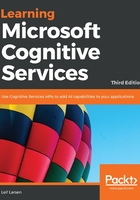
What this book covers
Chapter 1, Getting Started with Microsoft Cognitive Services, introduces Microsoft Cognitive Services by describing what it offers and providing some basic examples.
Chapter 2, Analyzing Images to Recognize a Face, covers most of the image APIs, introducing face recognition and identification, image analysis, optical character recognition, and more.
Chapter 3, Analyzing Videos, introduces the Video Indexer API.
Chapter 4, Letting Applications Understand Commands, goes deep into setting up the Language Understanding Intelligent Service (LUIS) to allow your application to understand the end users' intentions.
Chapter 5, Speaking with Your Application, dives into different speech APIs, covering text-to-speech and speech-to-text conversions, speaker recognition and identification, and recognizing custom speaking styles and environments.
Chapter 6, Understanding Text, covers a different way to analyze text, utilizing powerful linguistic analysis tools and much more.
Chapter 7, Building Recommendation Systems for Businesses, covers the Recommendation API.
Chapter 8, Querying Structured Data in a Natural Way, deals with the exploration of academic papers and journals. Through this chapter, we look into how to use the Academic API and set up a similar service ourselves.
Chapter 9, Adding Specialized Search, takes a deep dive into the different search APIs from Bing. This includes news, web, image, and video search as well as auto suggestions.
Chapter 10, Connecting the Pieces, ties several APIs together and concludes the book by looking at some natural steps from here.
Appendix A, LUIS Entities, presents a complete list of all pre-built LUIS entities.
Appendix B, License Information, presents relevant license information for all third-party libraries used in the example code.